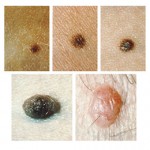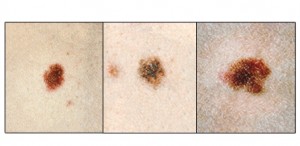A common mole is a growth on the skin that develops when pigment cells (melanocytes) grow in clusters. As a baby in your birthday suit you might not have had any moles, but chances are you have a few now. Most everyone develops 10 to 40 moles, according to the National Institutes of Health, or NIH. These growths are usually found above the waist on areas exposed to the sun. They are seldom found on the scalp, breast, or buttocks. While most moles are nothing to worry about, the NIH says, some may develop into skin cancer. That is why you should keep track of moles on your body and take note of any that look unusual.
The Origin of Moles
Moles are benign tumors that come from melanocytes. Melanocytes are cells in the skin that make the pigment, melanin. We don’t really understand why some melanocytes are altered and develop into moles, although it seems to be linked to genetics and sun exposure.
Types
Moles, also called nevi, are skin cells that grow in a cluster with the surrounding tissue. The NIH says most moles develop before age 40 and can take on a variety of appearances–but usually are pink, tan or brown, in a round or oval shape and smaller than a pencil eraser. Â People who have dark skin or hair tend to have darker moles than people with fair skin or blonde hair. Several factors may increase the size and pigmentation of moles:
- Puberty
- Pregnancy
- Sun exposure
Abnormal moles, called dysplastic nevi, can develop into skin cancer called melanoma, according to the NIH. It is important to learn how to do a skin self-examination to look for concerning changes in moles.
Self-Examination for Melanoma
Examine your skin frequently to get used to the usual appearance of your moles. This makes it easier to know if any of your moles are changing. The following is a system recommended by the American Academy of Dermatology to examine your skin:
- Examine your body front and back in the mirror, then right and left sides with arms raised.
- Bend your elbows and look carefully at your forearms, upper underarms, underarms, and palms.
- Look at the backs of your legs and feet, the spaces between your toes, and the soles of your feet.
- Examine the back of your neck and scalp with a hand mirror. Part your hair for a closer look.
- Check your back and buttocks with a hand mirror.
Spotting Problems
Changes in a mole’s size, shape or color could be clues that it is becoming malignant, according to the American Cancer Society article “How Is Melanoma Found?” The Society recommends an “ABCD” rule: Look for Asymmetry, an irregular Border, a variation in Color or a Diameter larger than about 1/4-inch. According to a Mayo Clinic article on moles, other possible danger signs are moles that hurt, itch, burn, ooze, bleed or are scaly.
Risk Factors
Unprotected exposure to sun increases your risk for all skin cancers, including melanoma, and may cause more moles to develop, according to an American Academy of Dermatology report on moles.
A dysplastic nevus is a type of mole that looks different from a common mole. (Some doctors use the term “atypical mole†to refer to a dysplastic nevus.) A dysplastic nevus may be bigger than a common mole, and its color, surface, and border may be different. It is usually more than 5 millimeters wide. A dysplastic nevus can have a mixture of several colors, from pink to dark brown. Usually, it is flat with a smooth, slightly scaly, or pebbly surface, and it has an irregular edge that may fade into the surrounding skin. A dysplastic nevus may occur anywhere on the body, but it is usually seen in areas exposed to the sun, such as on the back. A dysplastic nevus may also appear in areas not exposed to the sun, such as the scalp, breasts, and areas below the waist. Some people have only a couple of dysplastic nevi, but other people have more than 10. Also, the report says, moles that you were born with are more likely than others to become cancerous.
Early Detection
As with other cancers, melanoma is most curable when it is found early, according to the American Cancer Society. Check your body about once a month–getting someone to help you if necessary–and keep track of any new moles or any changes. Have your doctor look at any mole that seems unusual, the Society advises.
Treatment
A dermatologist can cut out a larger mole or shave off a smaller one, according to the American Academy of Dermatology. Follow-up care may be needed if lab analysis of the mole finds that it was malignant. Also, be sure to return to the doctor promptly if a mole that was removed grows back, the Academy advises.



